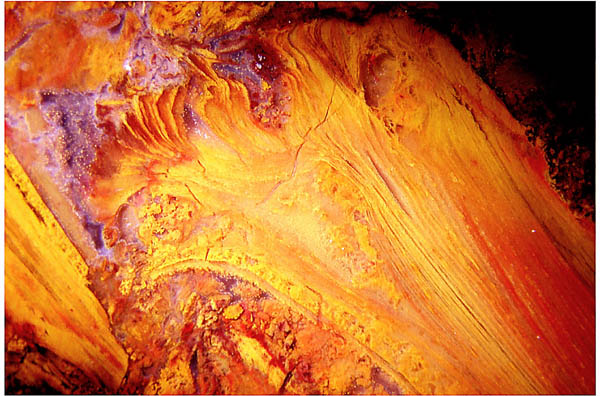Biogenic iron oxide precipitates in
red
cherts from Döhlen basin, Saxony
Large iron ore deposits known as banded iron formations were formed
about 2·109
years ago as a result of photosynthetic oxygen production
by cyanobacteria. This has been elaborated in [1], where it is
stated that "banded iron formations are laminated units
containing iron oxides, sometimes in very fine laminae, separated by
silica-rich layers". This can be vividly illustrated by much younger
terrestrial formations as preserved in Lower Permian cherts (Fig.1).

Fig.1:
Iron oxides precipitated probably by cyanobacteria grown in very fine
laminae before all turned into chert by silicification of the watery
habitat. Width of the picture 17.5mm.
Several fossiliferous chert varieties have been found as pebbles and
boulders in (glacial ?) fluviatile
deposits but never in-situ in the small Döhlen basin, Upper Saxony,
Germany. Nevertheless they are thought to be of Lower Permian age like
the basin itself because a few of them have retained more or less sharp
edges, indicating short transport distances, and one variety resembling
the one described here
was found as a red chert layer of about 10cm thickness in the coal mine
"Marienschacht" [2] and as sharp-edged fragments on a nearby field.
(Several other types of chert, probably formed
by silicifation in the depth and virtually without fossils,
were found in mines, as mentioned in [3,4].)
The finely
laminated iron oxide precipitates found in some of the red and yellow
cherts from Döhlen basin look so similar to those from the Proterozoic
banded iron formation, which are thought to be brought about by the
physiological activity of cyanobacteria, that one can well assume that
they, too, had originated in that way, although the involvement of
cyanobacteria in the cherts considered here has never been proven
directly.
The present sample is a fragment of a chert layer of at least
23cm thickness. Judging from the presence of foliage fragments and
air-filled roots of the tree fern Scolecopteris,
the colourful
structures must have formed in a shallow swamp near the surface, since
the cyanobacteria need water to live in and light for photosynthesis.
This is compatible with the observation that the laminated precipitates
are always disturbed as a result of some commotion in the swamp,
possibly caused by strong winds, animals, falling fern fronds ...
The
disturbances occurred during different stages of silicification, as can
be concluded from Fig.1: Obviously the stack of layers had been torn
into pieces while all was still fluid, and the individual limpid sheets
separated themselves at the end of the piece seen here. Later, when the
deformed stack fragment had obtained a jelly consistence, a crack ran
across but no
further. This indicates that silicification combined with shrinkage was
faster in the layer stack than in its vicinity.

Fig.2:
Chert with iron oxides precipitated on microbial formations grown
among plant debris, same sample as in Fig.1, fungus chlamydospores
faintly seen as transparent
hollow spheres.
Width of the picture 5.5mm.
Microbes in water
come more often as a multitude of floccules than as a stack of thin
sheets. It is not known whether or not the sheets and floccules in
Fig.2 (below left and above right) represent the same microbe species.
Occasionally seen smooth transitions between the two forms seem to
indicate that they do.
There are more features worth mentioning in
Fig.2. A former cavity, probably a swamp gas bubble, is now filled with
coarse quartz. A similar cavity with a level fill (not shown here)
reveals the orientation of the sample during silicification so that it
can be stated that the orientation of Figs.1,2 is the original one.
Small bubble-like objects, 0.17 ... 0.27mm across, faintly seen
randomly
arranged along the inclined strip of decayed plant matter in Fig.2, are
most probably "chlamydospores"
of some
fungus. They and the related hyphae are rare in the cherts of the
Döhlen basin but abundant in the Rhynie chert. Beside the cyanobacteria
or blue-green algae, their presence serves as additional evidence that
this type of chert, like lots of others, was not formed by
silicification of some sediment layer but by swamp water
turning into silica gel which finally became chert. This has to be
emphasized
in order to contradict
views adopted from outdated textbooks according
to which cherts are generally formed by silicification of strata in the
depth [5].
Sample: Found in 2001 among the excavated matter of a
construction pit at
Hänichen, Käferberg-Strasse 3. Kept in the own collection under the
label H/333.1
.
H.-J.
Weiss
2012
[1] T.N. Taylor
et al.: Paleobotany. Elsevier 2009
[2] J.T. Sterzel:
Die Flora des Rothliegenden im Plauenschen Grunde bei Dresden.
Abh. math.-phys. Cl. Kgl. Sächs. Ges.
Wiss. 19(1893), 1-172.
[3] K.
Thalheim,
W. Reichel, T.
Witzke: Die Minerale des Döhlener
Beckens.
Schr. Staatl. Mus. Mineral. Geol.
Dresden 3(1991), 1-131.
[4] W. Reichel,
J.-M. Lange:
Cherts from the Döhlen Basin near Dresden.
Geologica Saxonica 52/53(2007), 117-128.
[5] R. Rößler, T.
Zierold, F.
Spindler, F. Rudolph :
Strandsteine ...
Veröff. Mus. Naturkunde
Chemnitz 30(2007), 5-24.
|
 |
 8 8 |

 8
8


 8
8